Model Test of Stress and Displacement of Recyclable Anchor Rod Support Structure
Abstract
:1. Introduction
2. Model Test Scheme
2.1. Experimental Similarity Ratio Design
2.2. Test Material
2.3. Model Test Device
2.4. Introduction of the Test’s Recoverable Anchor Bolt
2.5. The Test Scheme
3. Test Results
3.1. Analysis of Bending Moment of Supporting Pile
3.2. Horizontal Displacement of Pile Top
3.3. Axial Force of Anchor Rod
3.4. Surface Settlement
3.5. Analysis of Soil Pressure Results behind Piles in the Process of Foundation Pit Excavation
3.6. Displacement Characteristics of Foundation Pit
3.7. Foundation Pit Backfilling Analysis
3.7.1. Analysis of Surface Settlement Results in the Backfilling Process
3.7.2. Analysis of Horizontal Displacement of Pile Top in the Backfilling Process
4. Conclusions
- (1)
- During the excavation process, the horizontal displacement of the pile top of the recoverable anchor-supporting structure exhibits a gradual upward trend. However, the rate of displacement increase at the pile top is comparatively lower under working conditions 1 and 3 compared to the other conditions. Moreover, a notable reduction in the bending moment of the supporting pile is observed around the lengths of 10 cm and 30 cm, which shows that the recoverable anchor can effectively limit the horizontal displacement of the top of the supporting pile.
- (2)
- The ground settlement of the common pile–anchor-supporting structure exhibits positive values in working condition 1 and negative in working condition 2. In contrast, the ground settlement of the recoverable anchor-supporting structure is consistently negative throughout. After excavation, the maximum ground settlement observed in the foundation pit with a recoverable anchor is 0.05% of the excavation depth.
- (3)
- The earth pressure distribution of the recoverable anchor-supporting structure exhibits a non-linear pattern. Initially, the earth’s pressure decreases, followed by a distinctive “R” shape distribution. Additionally, there is a positive correlation between the earth pressure distribution and the depth of excavation.
- (4)
- In the backfilling stage, both the horizontal displacement of the pile top and the surface settlement exhibit a progressive increase as the working conditions change. The surface settlement experiences the most significant increase when the anchor rod is pulled out from the lower layer, eventually reaching a state of relative stability. The maximum settlement recorded is 0.1% of the excavation depth. Therefore, it is necessary to increase the strength of the waist beam and the thickness of the shotcrete at the position of the lower anchor when the anchor is recovered. Furthermore, it is crucial to enhance monitoring efforts.
Author Contributions
Funding
Institutional Review Board Statement
Informed Consent Statement
Data Availability Statement
Acknowledgments
Conflicts of Interest
References
- Feng, Z.; Li, D. Study on safety optimization of embedded ratio of deep foundation pit support in sandy pebble. China Saf. Sci. J. 2021, 31, 125–131. [Google Scholar]
- Zhou, A.; Wang, B.; Li, J.; Zhou, X.; Xia, W. Long-term stability analysis and deformation prediction of soft soil foundation pit in Taihu Tunnel. J. Zhejiang Univ. Eng. Ed. 2022, 56, 692–701. [Google Scholar]
- Zheng, G.; Zhu, H.; Liu, X.; Yang, G. Foundation pit engineering and underground engineering safety and environmental impact control. J. Civ. Eng. 2016, 49, 1–24. [Google Scholar]
- Zhang, Q.; Liang, D.; Xu, C. Application of pile-anchor rod supporting structure in backfill area. J. Geotech. Eng. 2012, 34, 358–363. [Google Scholar]
- Li, M.; Chen, Q.; Zhao, X. Application of pile-anchor rod supporting technology in deep foundation pit engineering. Build. Struct. 2020, 50, 789–792. [Google Scholar]
- Peng, Y. Construction Design of Pile Anchor rod Support in Deep Foundation Pit Excavation. Int. J. Multiphysics 2021, 15, 19–28. [Google Scholar]
- Gang, L.; Huang, B. Analysis of deformation characteristics of adjacent buildings caused by deep foundation pit excavation with pile-anchor rod support. Constr. Technol. 2017, 46, 54–57. [Google Scholar]
- Liu, C.; Zhang, Z.; Lou, H.; Kuang, S. Application of prefabricated foundation pit supporting structure in Guangzhou. Geotech. Found. 2007, 4, 28–30. [Google Scholar]
- Fu, W.; Zou, J.; Huang, K. Research summary of recyclable anchor rod technology. Chin. J. Undergr. Space Eng. 2021, 17, 512–522, 528. [Google Scholar]
- Wu, R.; Xu, J.; Zhou, B.; Wang, Q. Development and application of new recyclable resin metal anchor rod. Min. Mach. 2011, 39, 19–22. [Google Scholar]
- Wei, Y. Analysis of the influence of foundation pit excavation on the surrounding environment. J. Lanzhou Univ. Technol. 2022, 48, 136–144. [Google Scholar]
- Jin, J.; Du, H.; Zhang, Z.; Guo, Y.; Song, W. Analysis of pile-anchor rod soil nailing composite support in complex environment. J. Shenyang Jianzhu Univ. Nat. Sci. Ed. 2017, 33, 613–620. [Google Scholar]
- Zhang, B.; Huang, X.; Song, N. Analysis of anchor rod rod (cable) of pile-anchor rod supporting structure in deep foundation pit. Sichuan Build. Sci. Res. 2015, 41, 168–171. [Google Scholar]
- Ma, J. Application of recyclable spin soil nail anchor rod pipe in Xi ‘an Metro Line 4. Road Mach. Constr. Mech. 2017, 34, 80–83. [Google Scholar]
- Gong, X.; Yu, J. Development and prospect of recyclable anchor rod technology. J. Civ. Eng. 2021, 54, 90–96. [Google Scholar]
- Du, C.; Xiao, T.; He, Y.; Yang, X. Experimental and Numerical Studies on the Inflatable Recyclable Anchor rod in the Tube Piece Type Based on the Soil-Anchor rod Interaction Mechanism. Adv. Civ. Eng. 2021, 2021, 8866211. [Google Scholar]
- Chen, Z.; Xiang, J.; Ding, W. Numerical analysis of mechanical properties of large diameter recyclable anchor rod. J. Geotech. Eng. 2012, 34, 172–176. [Google Scholar]
- Yu, L.; Yu, Z.; Wang, W.; Han, Z.; Zhao, T. Stress and deformation analysis of assembled recyclable support and pile-anchor rod support structure for foundation pit. J. Jilin Univ. Earth Sci. Ed. 2021, 51, 1789–1800. [Google Scholar]
- Liu, G.; Lian, B. Proposal and experimental study of the expanded anchor rod structure with recyclable fast anchor rod. J. Earthq. Eng. 2022, 44, 551–557. [Google Scholar]
- Li, H.; Zhang, K. Application of recyclable anchor rod in foundation pit supporting engineering. J. Build Struct. 2019, 49, 110–114+21. [Google Scholar]
- Zheng, Q.; Zhang, X.; Liu, J.; Liu, Y.; He, D.; Wang, Y.; Feng, X. Mechanical properties of foundation pits and basements during pile-anchor rod recovery. J. Jinan Univ. Nat. Sci. Ed. 2022, 36, 16–20. [Google Scholar]
- Liu, W.; Ge, M.; Wan, J.; Yu, L.; Hai, J. Numerical analysis of deformation characteristics and influencing factors of deep and large foundation pit supported by pile-anchor rod considering spatial effect. J. Railw. Sci. Eng. 2021, 18, 3188–3200. [Google Scholar]
- Li, J.; Li, L. Numerical Analysis on a New Pressure-Type Anchor Rod Cable with Precast Anchor Rod Head Based on FLAC3d: 2nd International Conference on Electronics. Network and Computer Engineering (ICENCE 2016); Atlantis Press: Amsterdam, The Netherlands, 2016. [Google Scholar]
- Craig, W.H. Simulation of foundations for offshore structures using centrifuge modelling. In Developments in Soil Mechanics and Foundation Engineering: Model Studies; Applied Science Publisher: London, UK, 1983. [Google Scholar]
- GB 50123-2019; Standard for Soil Method. Ministry of Housing and Urban-Rural Development of the People’s Republic of China (MOHURD): Beijing, China, 2019.
- Zhou, S.; Zhang, Y.; Li, Q.; Li, D.; Wang, W.; Shi, M.; Chen, W. An Externally Installed Friction Nail Recyclable Anchor Rod. Patent CN111075486B, 15 June 2021. [Google Scholar]
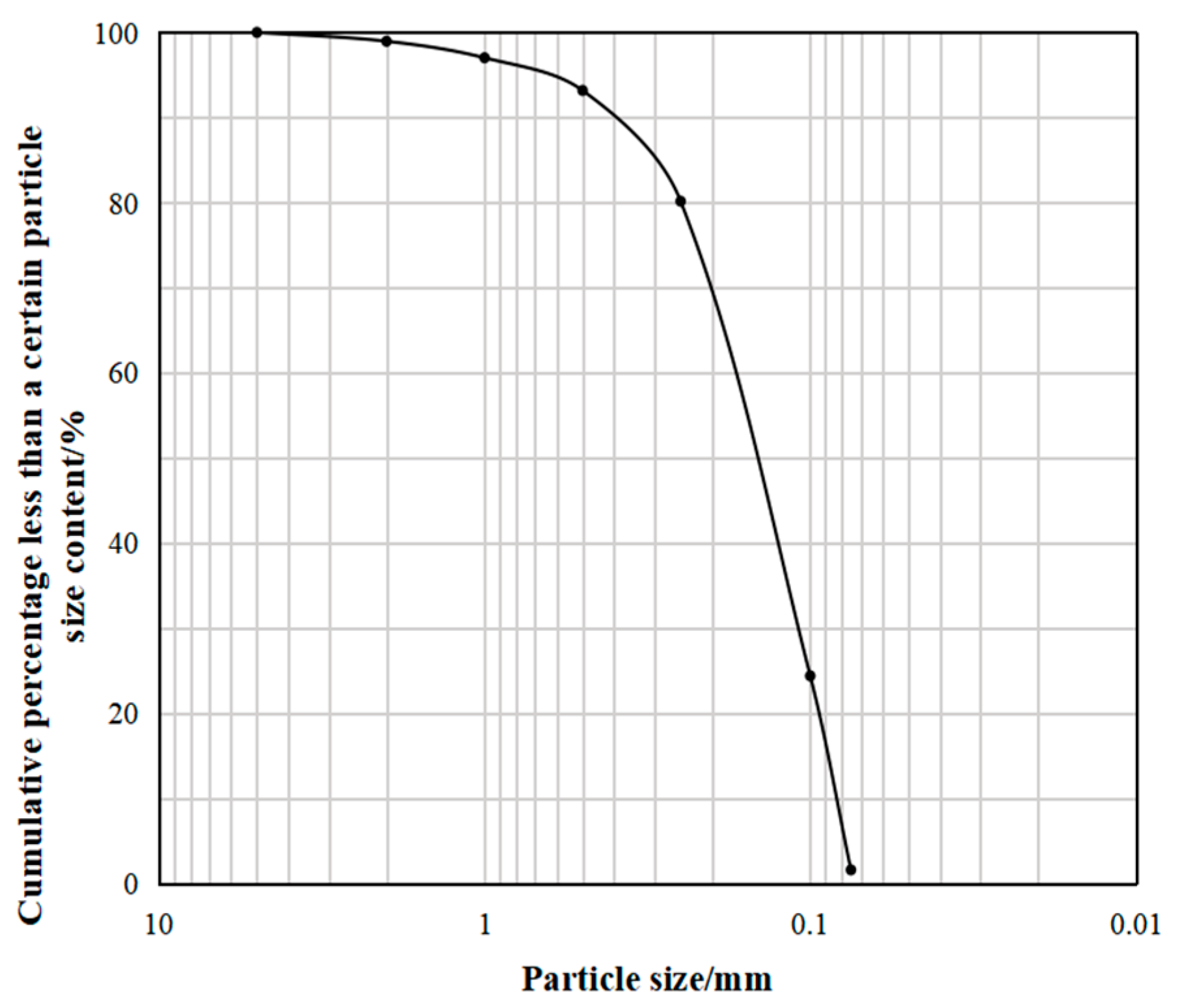
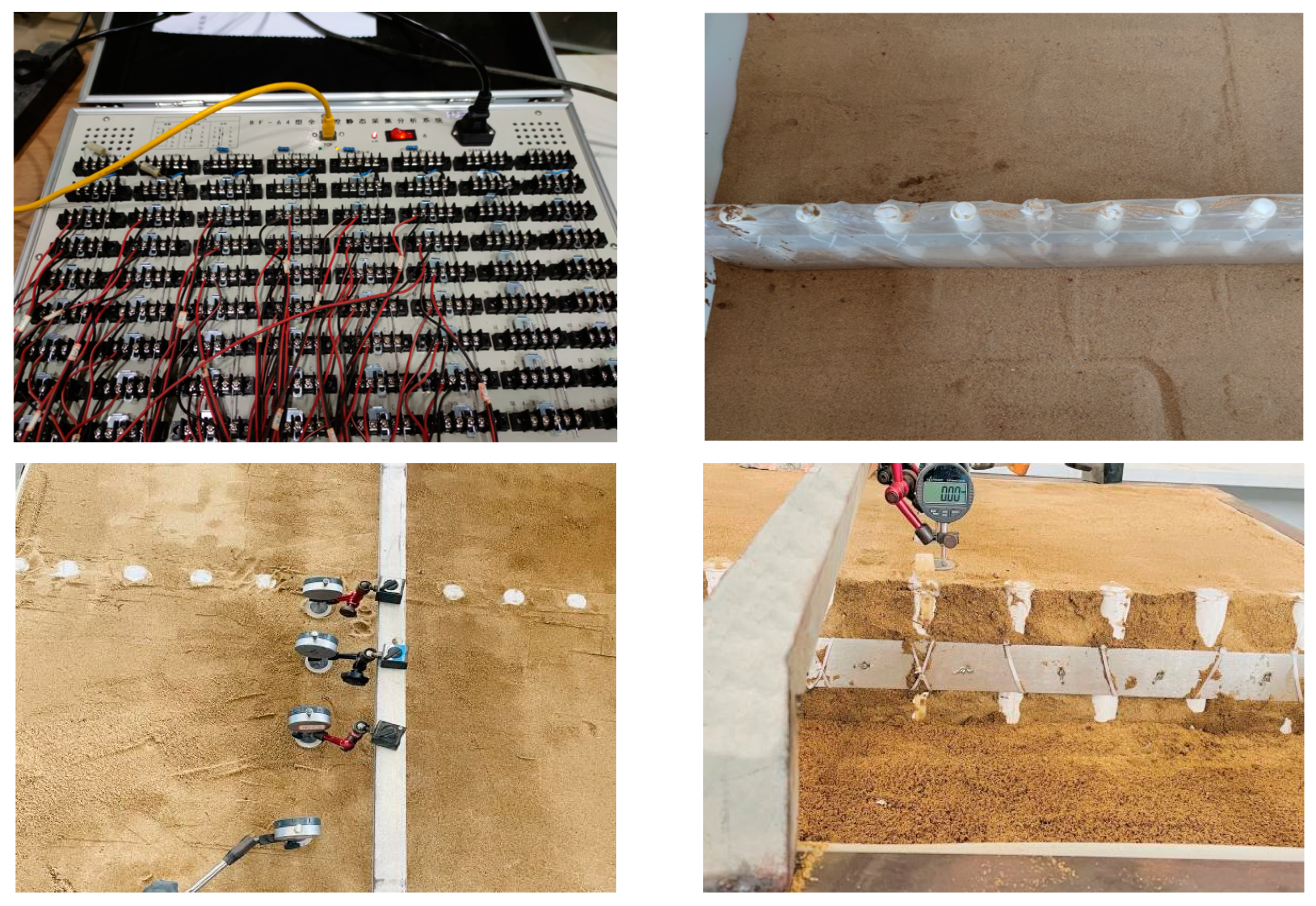
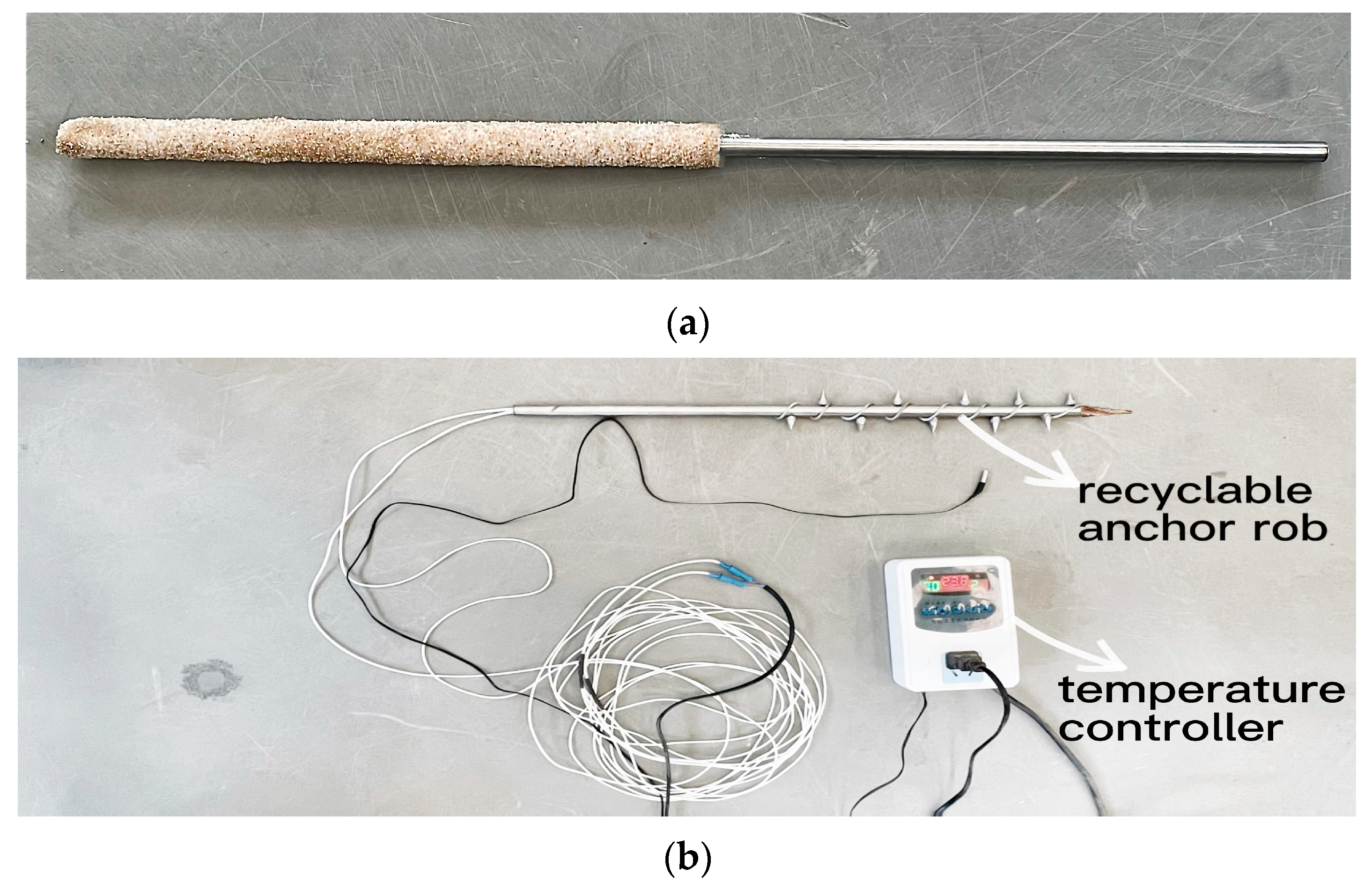

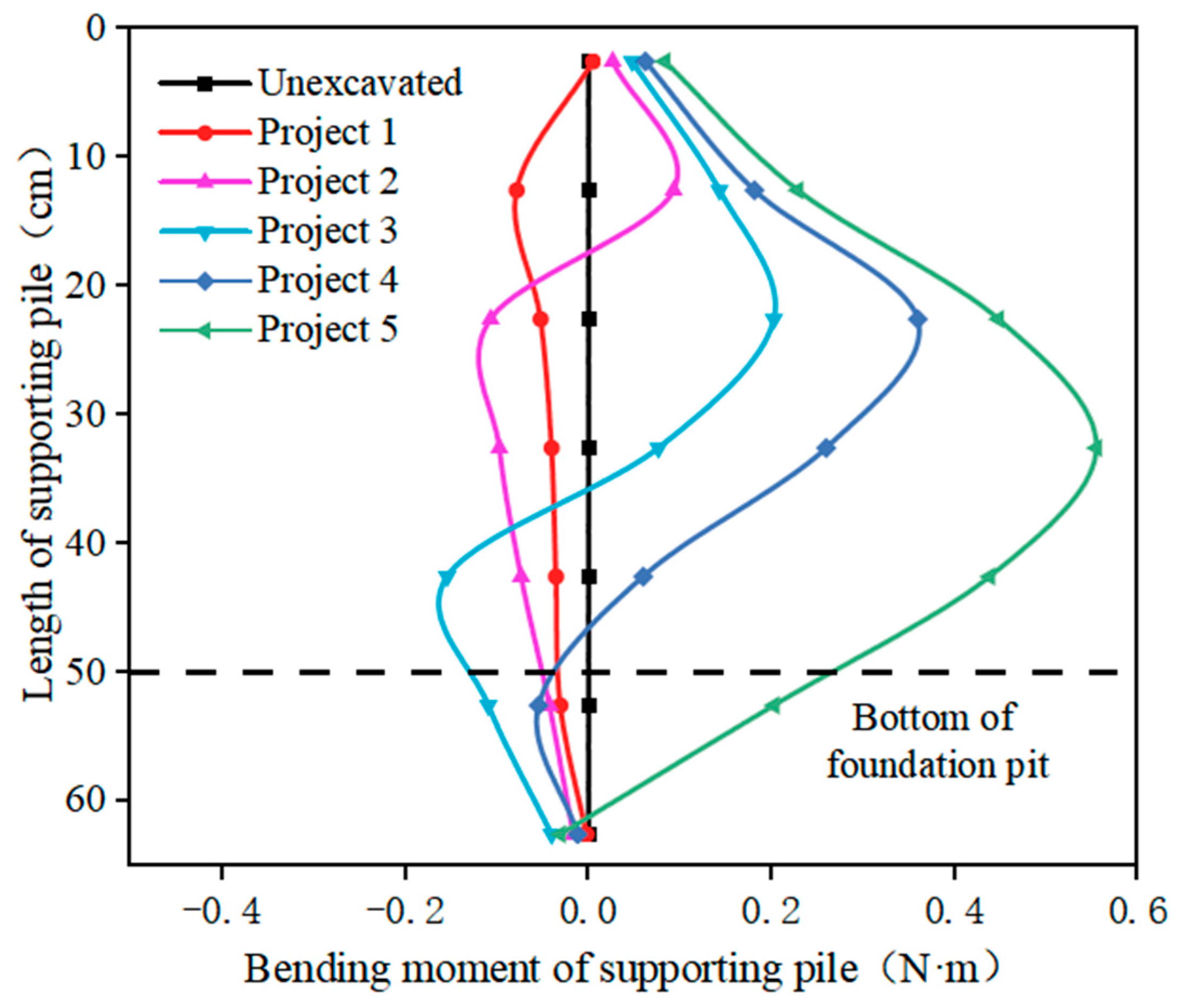
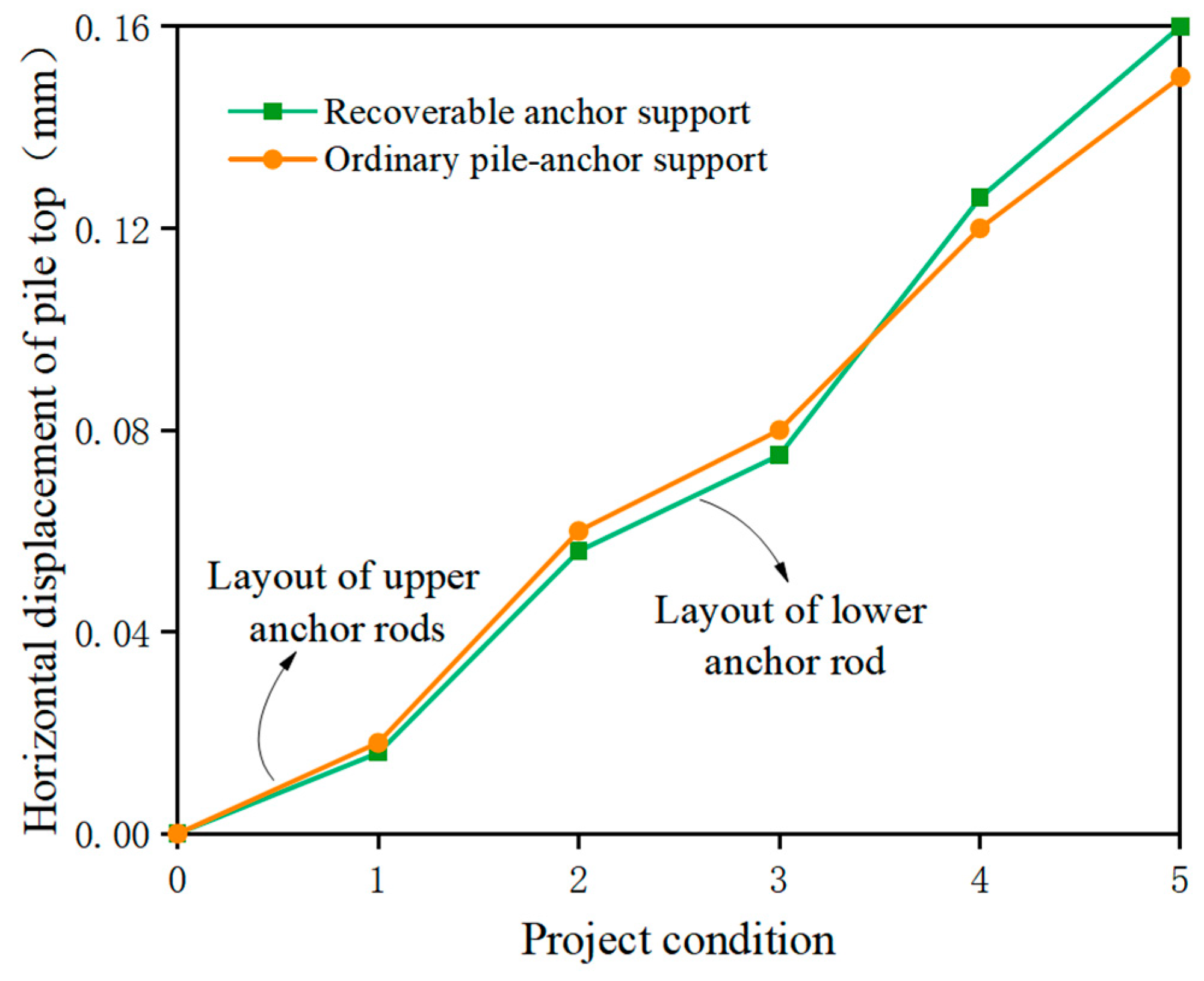

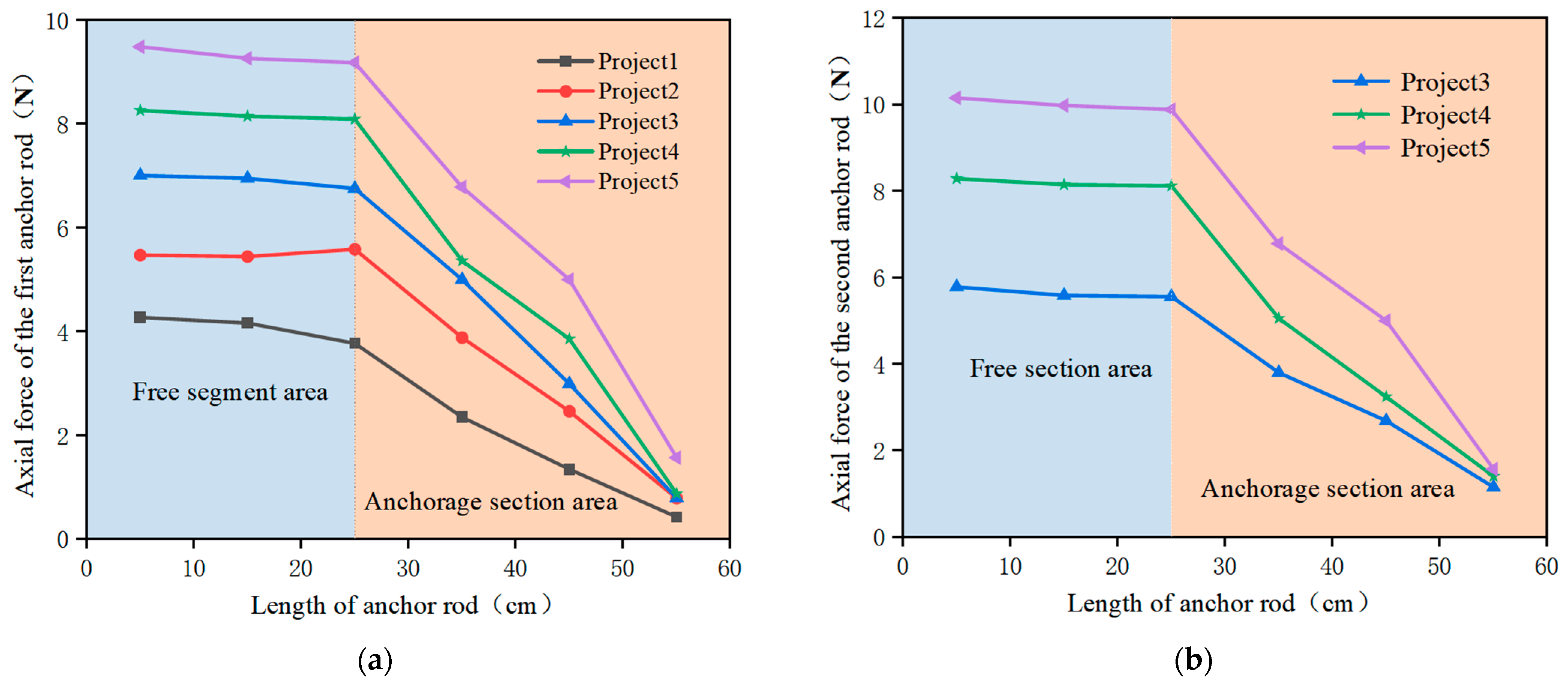
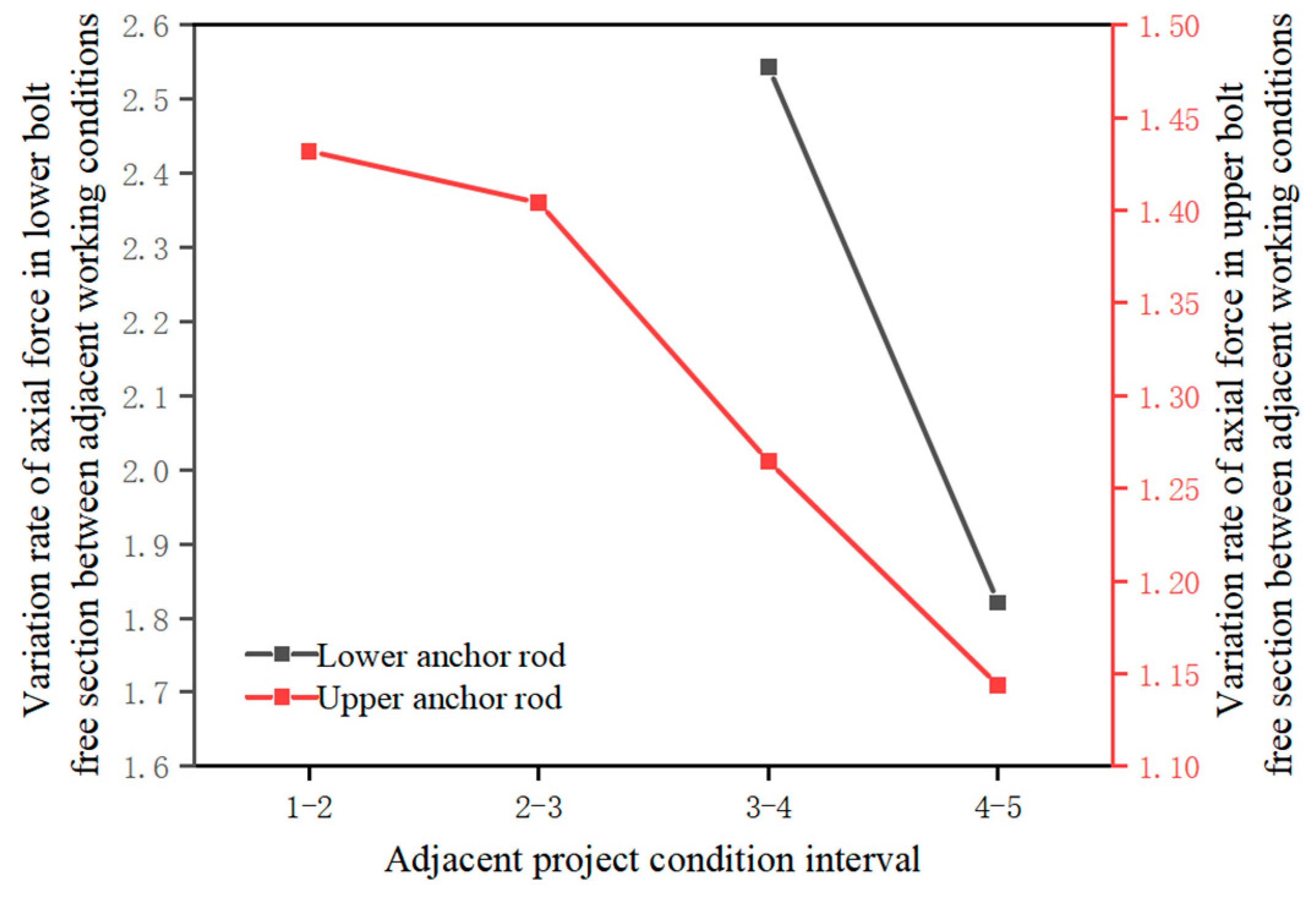
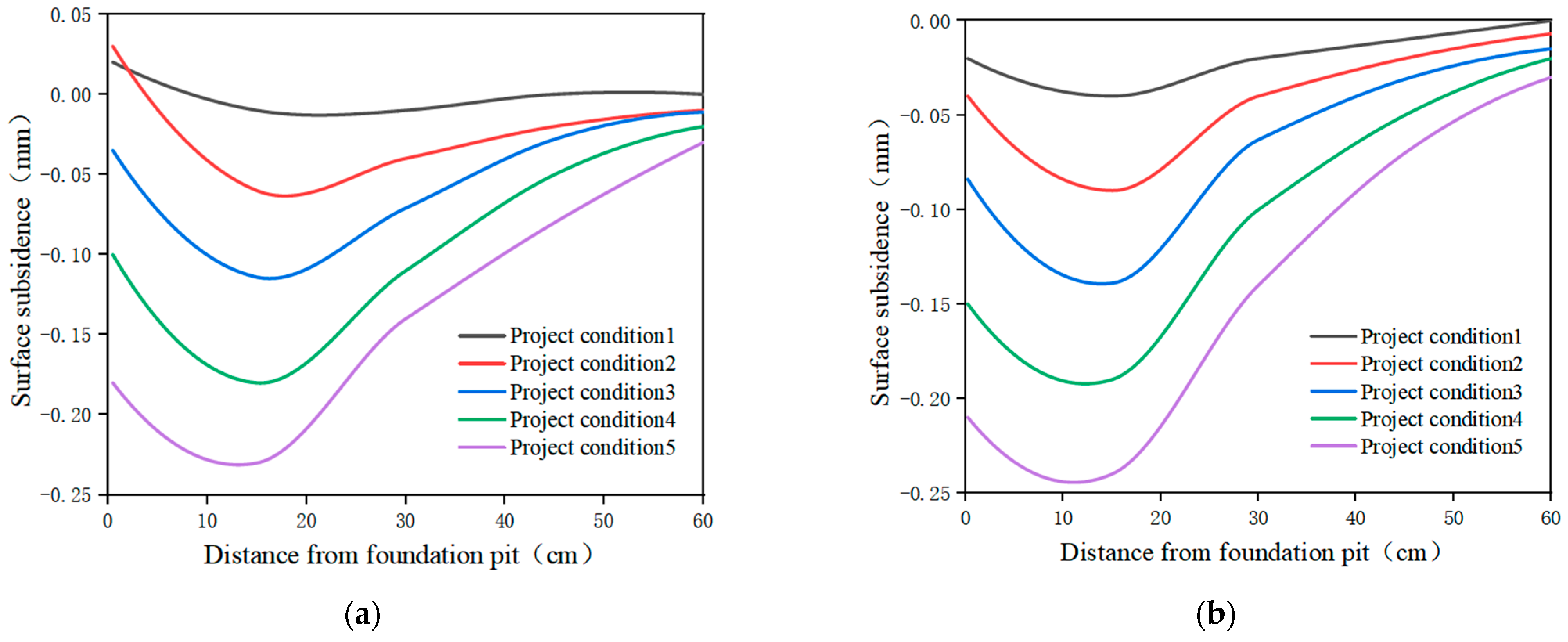
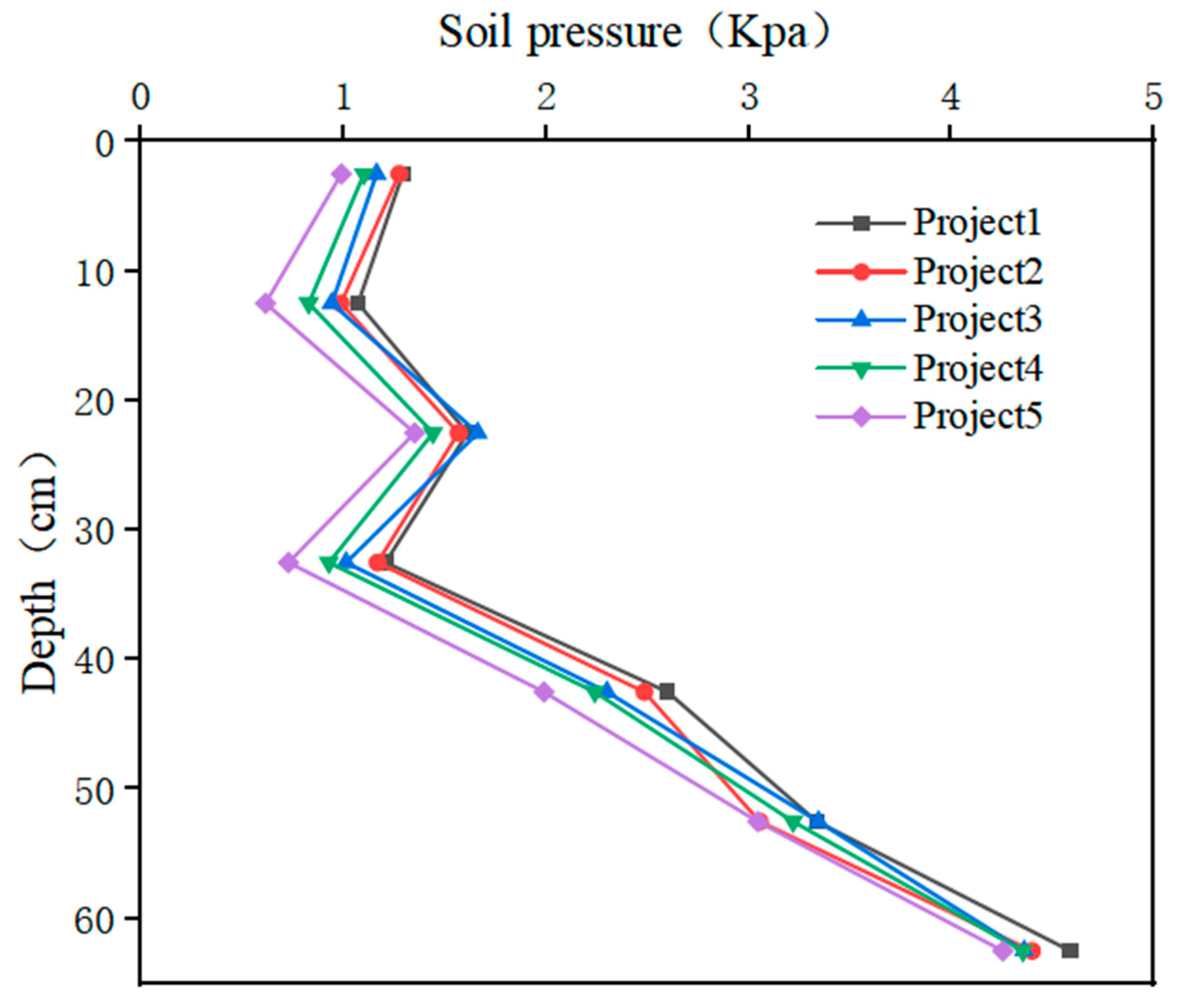
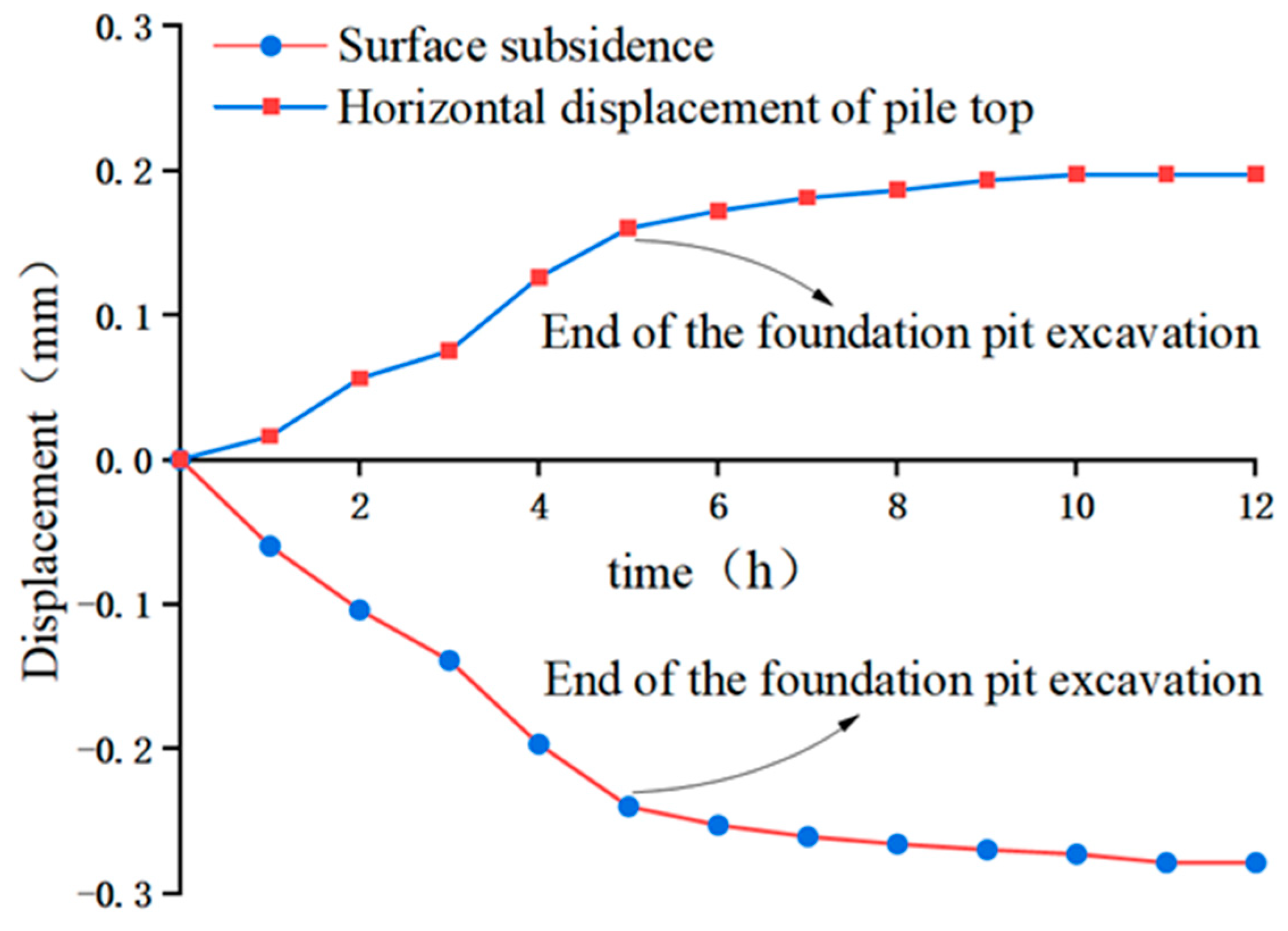

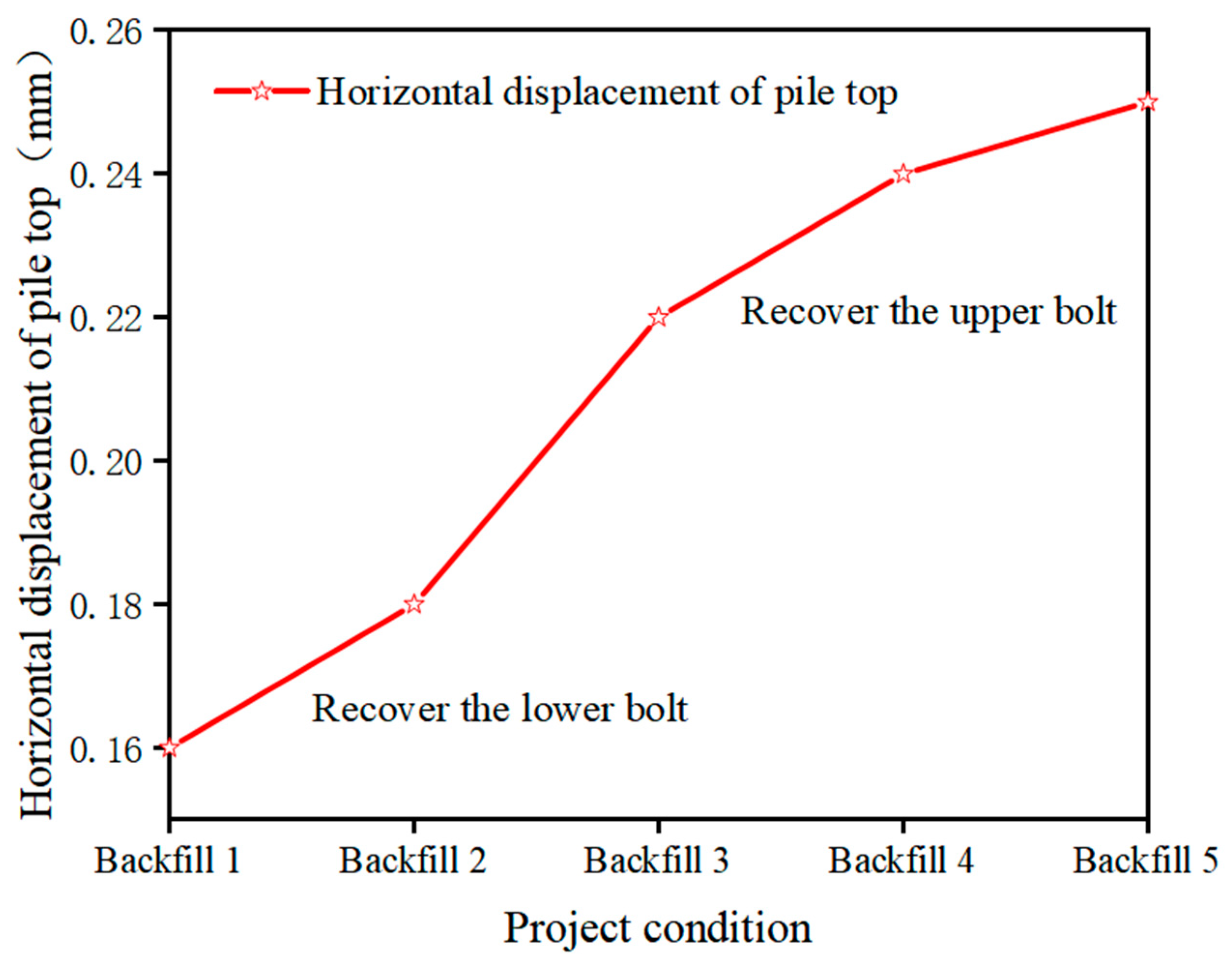
| Parameters | Prototype | Model | Similarity Ratio |
|---|---|---|---|
| Foundation pit depth/m | 12.5 | 0.5 | 25 |
| support pile length/m | 16 | 0.65 | 24.62 |
| support pile diameter/m | 0.8 | 0.032 | 25 |
| anchor length/m | 16 | 0.60 | 26.67 |
| support pile elastic modulus/GPa | 30 | 2.85 | 10.53 |
| anchor elastic modulus/GPa | 210 | 8.35 | 26 |
| Project Condition | Type | Anchor Rod | Depth (cm) |
|---|---|---|---|
| 1 | Excavation and laying of an anchor rod | Anchor rod 1 | 10.00 |
| 2 | Excavation | 20.00 | |
| 3 | Excavation and laying of an anchor rod | Anchor rod 2 | 30.00 |
| 4 | Excavation | 40.00 | |
| 5 | Excavation | 50.00 |
Disclaimer/Publisher’s Note: The statements, opinions and data contained in all publications are solely those of the individual author(s) and contributor(s) and not of MDPI and/or the editor(s). MDPI and/or the editor(s) disclaim responsibility for any injury to people or property resulting from any ideas, methods, instructions or products referred to in the content. |
© 2023 by the authors. Licensee MDPI, Basel, Switzerland. This article is an open access article distributed under the terms and conditions of the Creative Commons Attribution (CC BY) license (https://creativecommons.org/licenses/by/4.0/).
Share and Cite
Zhou, S.; Feng, S.; Dai, C.; Xu, Q.; Ke, Z. Model Test of Stress and Displacement of Recyclable Anchor Rod Support Structure. Appl. Sci. 2023, 13, 7713. https://doi.org/10.3390/app13137713
Zhou S, Feng S, Dai C, Xu Q, Ke Z. Model Test of Stress and Displacement of Recyclable Anchor Rod Support Structure. Applied Sciences. 2023; 13(13):7713. https://doi.org/10.3390/app13137713
Chicago/Turabian StyleZhou, Shengquan, Shaotong Feng, Chen Dai, Qiuwei Xu, and Zhaibang Ke. 2023. "Model Test of Stress and Displacement of Recyclable Anchor Rod Support Structure" Applied Sciences 13, no. 13: 7713. https://doi.org/10.3390/app13137713
APA StyleZhou, S., Feng, S., Dai, C., Xu, Q., & Ke, Z. (2023). Model Test of Stress and Displacement of Recyclable Anchor Rod Support Structure. Applied Sciences, 13(13), 7713. https://doi.org/10.3390/app13137713





